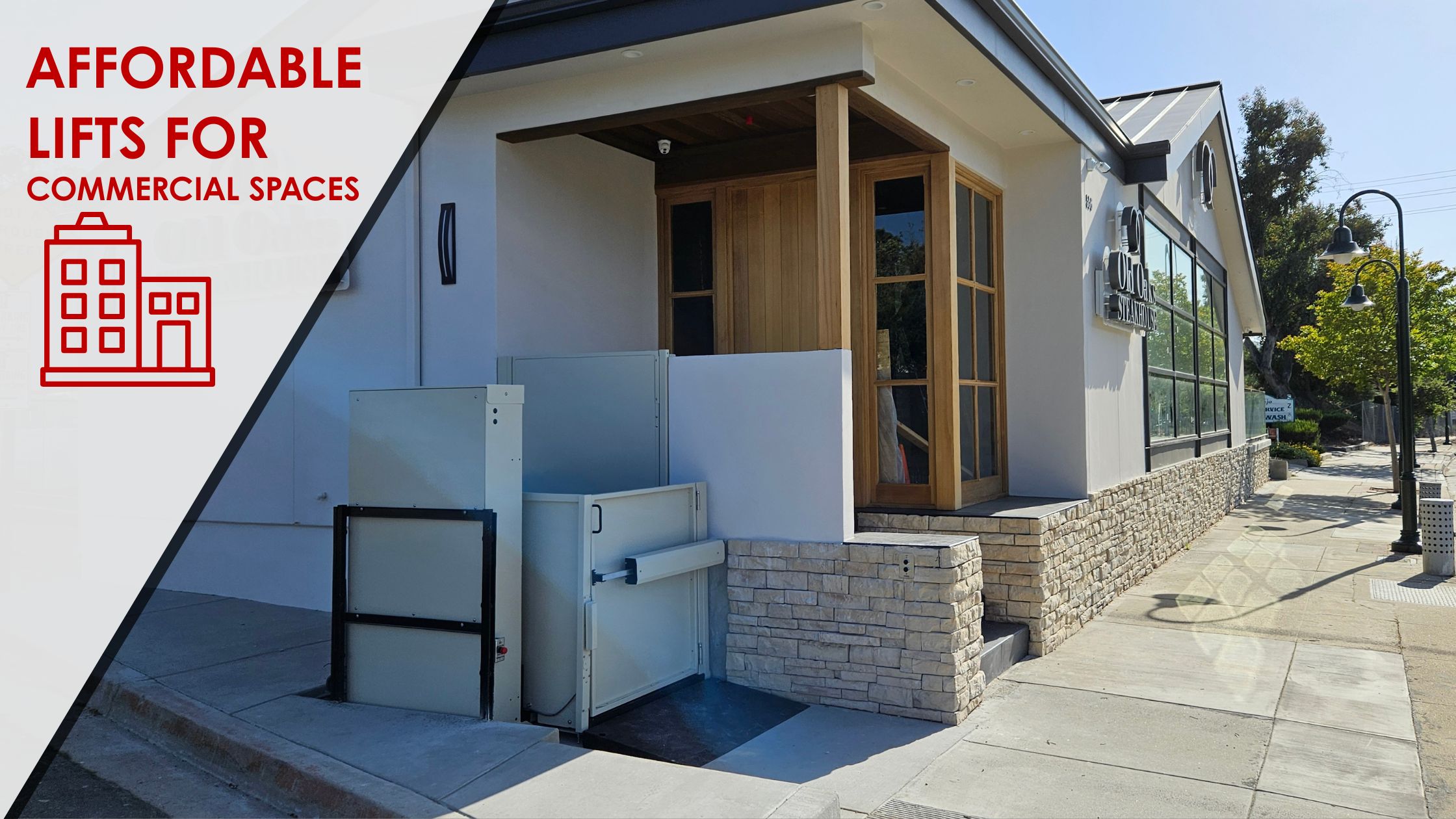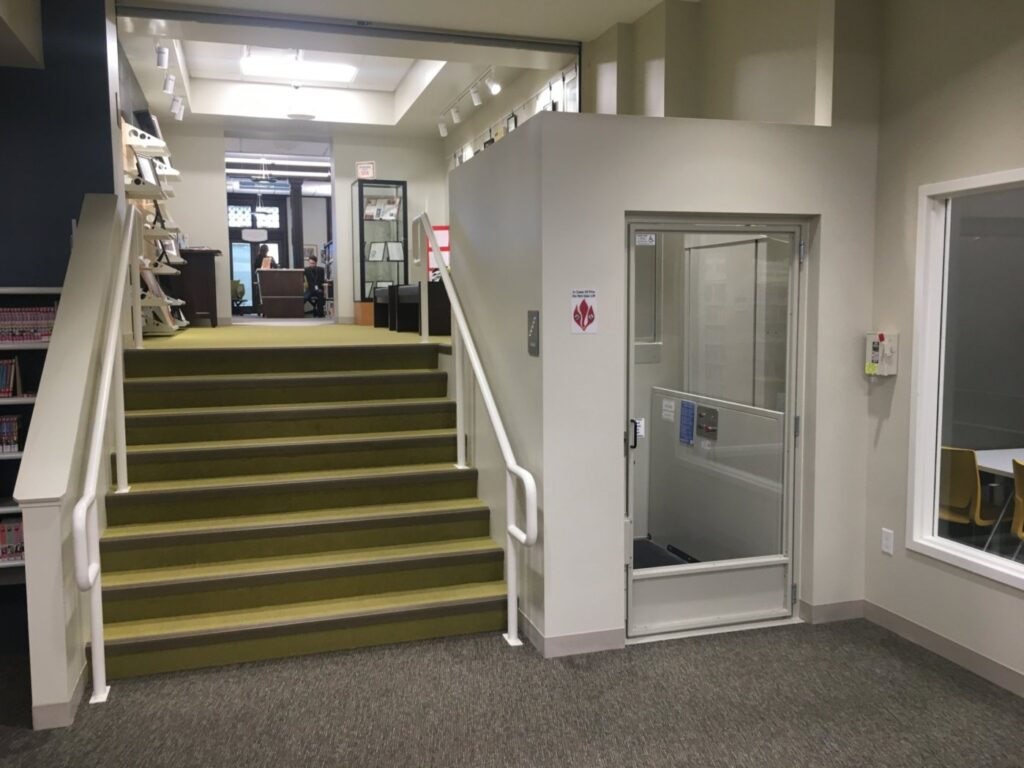
For some building owners, making your commercial space accessible is mostly about achieving ADA compliance. For others, it’s about creating a welcoming environment for everyone who walks through your door. Either way, when your building is ADA-compliant, you’re also expanding your reach and creating a better experience for all visitors.
In short, accessible spaces lead to happier customers and loyal repeat business.
Even better? Accessibility upgrades don’t have to come with a sky-high price tag. Whether you’re updating an existing space or building from the ground up, commercial accessibility solutions can be versatile and cost-effective. An affordable wheelchair lift is within reach!
Let’s explore the most popular accessibility options, including commercial passenger elevators, LULA lifts, vertical platform lifts (VPLs), and ramps. Each has its place depending on your situation, budget, and space constraints. Understanding the pros, cons, and costs of each option will help you make an informed decision that works for both your accessibility needs and your bottom line.
Ramps: The Simple Solution with Hidden Tradeoffs
Ramps are often assumed to be an easy solution for commercial spaces, because they’re simple, don’t require power, and enable access for wheelchairs, scooters, and walkers. However, while they’re a familiar and straightforward option, designing the right ramp does take careful planning to ensure safety, compliance, and cost-effectiveness.
Ramps also take up a surprising amount of space, making them the least space-efficient option of all commercial accessibility solutions. According to ADA guidelines, for every inch of vertical rise, you need at least 12 inches of ramp length. That means even a modest 24-inch rise would require 24 feet of ramp, not including the landing spaces. Ramps also need to be at least 36 inches wide and, whether they are built out of concrete, wood or metal, those costs and space requirements can add up quickly.
Beyond construction, ramps will also require upkeep. Regular maintenance, like clearing snow, leaves, and debris, can help ensure outdoor ramps remain safe and functional year-round, but cost time and money throughout the year.
In more compact commercial spaces, it’s also important to weigh the footprint a ramp requires. Allocating ramp space may reduce room for parking, seating, or other features. That’s why it’s helpful to consider all your options, especially when space or layout limitations are in play.
In some cases, alternative solutions, like affordable commercial accessibility lifts, may use space more efficiently without compromising accessibility.
Vertical Platform Lifts: Accessibility Meets Affordability

For businesses where space is at a premium, vertical platform lifts (VPLs) provide a smart and compact solution. VPLs, which are sometimes called vertical wheelchair lifts or ADA lifts, are designed to handle elevation changes up to 14 feet while requiring minimal floor space. They can often fit into areas as small as a closet or stairwell landing, and consist of a small platform that travels vertically along a guide rail system.
Vertical wheelchair lifts are particularly valuable in retrofit situations where adding a ramp would consume valuable floor space or require expensive structural changes. They can be installed both indoors and outdoors, and many models can be customized to blend with your building’s architecture.
VPLs are also more affordable than you might think, especially when compared to the cost of pouring long concrete ramps or installing full commercial elevators. They’re the middle ground of accessibility spending, designed to be easy to use, ADA-compliant, and safe for both indoor and outdoor settings.
For many businesses, a vertical wheelchair lift strikes the perfect balance between function, form, and financial responsibility, delivering accessibility without sacrificing usable square footage.
Full-Sized Commercial Elevators: Maximum Access, Maximum Capability, Maximum Expense
When it comes to accessibility and convenience, full-sized commercial passenger elevators offer the most comprehensive solution. They serve multiple floors, transport groups of people, and accommodate heavy loads with ease. The question is when they’re the right fit for your space and goals.
For skyscrapers, hospitals, hotels, and large public buildings, full elevators aren’t just a convenience; they’re usually a code requirement. These systems are designed for high-traffic use, meet stringent safety standards, and add long-term value to a property.
That being said, commercial passenger elevators are typically the highest-cost option upfront, with similarly expensive ongoing maintenance costs. On the plus side, elevators are often the most familiar and intuitive option for users, requiring no special instructions or training.
The key is aligning the investment with your building’s usage and future plans. Elevators often deliver the strongest long-term return in high-traffic, multi-story commercial spaces. For buildings like these, nothing matches their capacity, convenience, and overall impact. However, these things come at a high cost, both up front and in ongoing maintenance.
LULA Elevators: The Middle Ground of Vertical Mobility
What happens when a full commercial elevator feels like overkill, but you need more capacity and travel distance than a vertical platform lift can provide? Enter LULA (Limited Use/Limited Application) elevators, the cost- and space-effective option that bridges the gap between VPLs and traditional elevators.
For buildings that don’t require a full commercial elevator, a LULA elevator can be the ideal in-between solution when you’re looking for an affordable wheelchair lift.
Sometimes called LULA lifts, these elevators are specifically designed for low-rise commercial spaces, such as offices, churches, schools, and retail shops. They can travel up to 25 feet vertically and carry two to five passengers at a time, making them perfect for two- or three-story buildings that still need reliable, ADA-compliant access.
LULA lifts combine the convenience of vertical mobility with a smaller footprint and a lower cost than full-sized elevators. While they do require a shaft and machine room , their structural and electrical needs are much simpler, which offers significant upfront cost savings to the building owner. This makes LULA lifts a practical option for many commercial spaces.
Because they operate under different code requirements than full commercial elevators, they often come with streamlined installation processes and reduced ongoing maintenance requirements. For many business owners, a LULA elevator provides just the right mix of functionality, accessibility, and affordability.
Factors That Affect Your Costs
Several factors influence the overall cost of any accessibility solution:
Site conditions: Existing structural elements, electrical access, and space constraints all impact the complexity and costs of installation and surrounding work by other trades.
Travel distance: The greater the elevation change, the more you’ll typically invest, regardless of which solution you choose.
Indoor vs. outdoor installation: Outdoor installations often require additional weatherproofing and may need more robust foundations. And of course, some accessibility solutions—such as commercial passenger elevators and LULA elevators—are not usually possible as outdoor installations.
Local building codes: Some jurisdictions have specific requirements that can influence which options are available and how they must be installed.
Usage patterns: High-traffic areas benefit from more robust solutions, while occasional-use applications can often utilize more basic options.
Making the Right Choice for Your Space
The best accessibility solution is the one that fits your space, your users, and your goals. For a small retail shop with a single step, a well-placed ramp might be all that’s needed. In contrast, a busy office building may benefit most from the long-term convenience and value of a commercial elevator.
The smartest approach looks beyond upfront costs to consider maintenance, energy efficiency, and how well the solution will support your space as it grows. The right choice will feel like a natural upgrade to your building.
With factors like space, code requirements, usage patterns, and budget in play, choosing an accessibility solution can feel complex, but it doesn’t have to be. Partnering with an experienced, local accessibility company simplifies the process and ensures you find the best fit for your building and your goals.
At Arrow Lift®, we’ve spent decades helping building owners, contractors, and architects navigate these decisions to find the most practical and cost-effective ADA-compliant solution for their unique spaces.
Creating accessible spaces goes beyond compliance. It’s about fostering a welcoming environment for everyone who enters your building. We’re here to help you approach accessibility as a meaningful investment in your community, your customers, and your business’s long-term success!
 Since 1985, Arrow Lift has been in the business of helping our customers overcome barriers. From
Since 1985, Arrow Lift has been in the business of helping our customers overcome barriers. From 